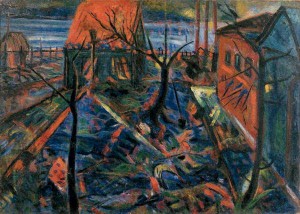Art appears when, in letting a person inquire about the world, it forces him to inquire about himself and to examine the flaws of his political culture. Art emerges as an expression of uncertainty and distrust, a feeling of betrayal by the system of contracts from which modernity issues its directives, announcements and reports. Art is a language that sets off the experience of the present against the experience of the past. This is why just about everything in this area is uncertain.
Art proposes speaking a language that cannot be mistaken for a means of recording, storing and transferring information. The language of art does, of course, carry out these functions, but the information at hand preserves the “true” meaning only as long as it is informing about its present condition, only as long as it is a present event and is speaking only of itself. As soon as the information starts informing about art in a broader, “historical” sense, it ceases to exist as such, and in its place, history begins.
The issue of expressionism in 20th century Russian art is, of course, tied to history. But not only. This is a question about the intentions of modern culture and its politics as a part of history.
First of all, one can approach expressionism as a style or direction in art. Expressionism is one version of European avant-gardism, a school with rather fixed historical (mid 1900s-late 1920s), and even geographical and political boundaries. In his 1923 introduction to George Martsinsky’s Expressionist Method in Painting, Nikolai Radlov noted, “Whereas cubism and futurism are cultivated by a small group of experts and theoreticians who are dispersed around the entire globe, expressionism completely lacks this caste-like quality. Though its locus is concentrated in a single country, expressionism is developing with a breadth and depth which point to its harmony with certain profound features of national spirit.” [1] If looked at from this approach, “expressionism” in Russian culture seems foreign and harmless.
From another point of view, the term “expressionism” can be taken to refer to an art idiom. This is what Nikolai Punin pointedly criticized when he wrote that “man became unhinged and let his emotions get the best of him.” [2] Expressionism is what an adherent of pure, constructive art finds unacceptable – “it gives unlimited possibilities, and presents no obstacles. The material has no substance; it only emotes.” [3] The polemic nature of this opinion recedes into the background behind its statement of the fact that expressionism is not limited to a national or historic school of art which realized one of the goals of 20th century European artistic endeavor. “The issue of expressionism can be equated with the issue of all Russian literature from Gogol to the present, and it is now also becoming an issue in painting … even constructivism is becoming expressive.” [4] Thus, in the formation and development of the art idioms that are unified by the term “expressionism”, the critic sees the consistent objectives of different artists and hears an unvarying tone in their voices as they seek to express the extreme states of art language.




Капитановский Александр
25 Aug 2012
Встретил Ваши тексты, прежде не довелось. Теперь читаю. С благодарностью и уважением.